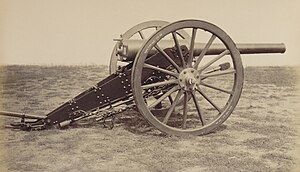The Lahitolle 95 mm cannon (Mle 1875) was a French cannon of the 19th century, developed in 1875 by the artillery commander de Lahitolle. The Lahitolle 90 mm was the first French field cannon made of steel, and one of the first to be equipped with a screw breech (issued 16 years after the British and Prussians adopted a similar system). It was adopted by the French Army in 1875 and later superseded the Reffye and de Bange 90 mm cannons. An improved version, the Lahitolle 95 mm (Mle 1888), was developed in 1888.
| Canon Lahitolle de 95 mm | |
|---|---|
 | |
| Type | Field gun Coastal artillery Fortress artillery Railway artillery |
| Place of origin | France |
| Service history | |
| In service | 1875–1945 |
| Used by | France Nazi Germany Kingdom of Italy |
| Wars | World War I World War II |
| Production history | |
| Designer | Henri Périer de Lahitolle |
| Specifications | |
| Mass | 1,413 kg (3,115 lb) |
| Barrel length | 2.28 m (7 ft 6 in) L/24[1] |
| Shell | Separate-loading, bagged charges and projectiles |
| Shell weight | 12 kg (26 lb 7 oz) |
| Caliber | 95 mm (3.7 in) |
| Breech | Lahitolle interrupted screw |
| Recoil | None[1] |
| Carriage | Box trail |
| Elevation | -10° to +24° |
| Traverse | None |
| Rate of fire | 1 rpm |
| Muzzle velocity | 400 m/s (1,300 ft/s) |
| Effective firing range | 6.5 km (4 mi) |
| Maximum firing range | 9.8 km (6 mi)[1] |
Coastal Artillery
editA version called the Canon de 95 sur affut de Cote mle 1904 was mounted on a Vavasseur mount with a gun shield for use in coastal defenses. The gun sat on a cradle that held the trunnioned barrel on top of a pedestal. When the gun fired a combination of inclined rails, and hydraulic buffers returned the gun to position.[2]
Fortress Artillery
editIn addition to its coastal defense role, Lahitolle 95 mm cannons were employed on pedestal mounts in France's Séré de Rivières system of fortifications. Approximately 475 cannons were used in coastal and land fortifications.[2]
Railway Artillery
editEarly in World War One, 16 coastal defense cannons were mounted on armored rail cars for use with France's armored trains. They are believed to have been retired by 1916.[3]
World War I
editThe Lahitolle 95 mm was still in use during World War I, together with the de Bange 90 mm cannon, as French industry could not keep with production requirements for the much newer Canon de 75.[4]
World War II
editThe Lahitolle 95 mm was still in use in the fortifications of the Maginot line during World War II.[5] Mle 1904 guns captured by the Germans were given the designation 9.5cm Küstenkanone (f) and used in Germany's Atlantic Wall fortifications.
Gallery
edit-
A rear view.
-
Lahitolle breech.
-
Diagrams of the Lahitolle 95 mm cannon.
-
A Lahitolle 95 mm cannon during the First World War.
-
Canon de 95 sur affut de cote mle 1904. On a Vavasseur mounting.
-
A mle 1904 at a sailors memorial at Plougonvelin (Finistère, France).
-
A mle 1904 at Jebel El Haouaria Tunisia.
-
An armored train with mle 1904 guns.
-
An armored train with mle 1904 guns.
-
An armored train with mle 1904 guns.
References
edit- ^ a b c "95 Mle 1888 sur affût de campagne". www.passioncompassion1418.com. Retrieved 2019-05-07.
- ^ a b "Canon de 95 Lahitolle affût campagne siège côte Grande Guerre". www.fortiffsere.fr. Retrieved 2021-02-19.
- ^ Romanych, Mark; Heuer, Greg; Noon, Steve (2017). Railway Guns of World War I. New Vanguard. London: Osprey Publishing. pp. 5–15. ISBN 9781472816412. OCLC 999616340.
- ^ Pyrrhic Victory: French Strategy and Operations in the Great War by Robert A. Doughty p.117 [1]
- ^ The Maginot Line
External links
edit- 1888 model at the Draguignan museum with the wheel brakes deployed